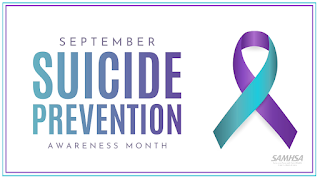Demystifying Non-suicidal Self-Injury
Non-suicidal Self-Injury (NSSI) is defined as the deliberate destruction of bodily tissue without conscious suicidal intent (Nock & Favazza, 2009). This behavior is rather complicated mental health phenomenon for people to understand because it's hard to grasp how a person could harm themselves without intent to kill. It's further complicated by the fact that we all have stereotypical images of what non-suicidal self-injury looks like. Below I will provide a brief summary of a important information that I feel all administrators, educators and mental health professionals should know about non-suicidal self-injury. A workshop called "Demystifying Non-suicidal Self-Injury" is being offered by Student Services this Fall and possibility this Spring which will go into more details concerning this behavior, prevention and intervention.
Duggan, J. M., Heath, N. L., Toste, J. R., & Ross, S. (2011). School Counsellors' Understanding of Non-Suicidal Self-Injury: Experiences and International Variability/La compréhension de l'automutilation non-suicidaire chez les conseillers scolaires: Les expériences et la variabilité internationale. Canadian Journal of Counselling and Psychotherapy (Online), 45(4), 327.
Nock, M. K., & Favazza, A. R. (2009). Nonsuicidal self-injury: definition and classification (Vol. xiii). Washington, DC: American Psychological Association. Google Scholar.
Whitlock, J., Muehlenkamp, J., Eckenrode, J., Purington, A., Abrams, G. B., Barreira, P., & Kress, V. (2013). Nonsuicidal self-injury as a gateway to suicide in young adults. Journal of Adolescent Health, 52(4), 486-492.Whitlock, J., & Rodham, K. (2013, December). Understanding nonsuicidal self-injury in youth. In School Psychology Forum(Vol. 7, No. 4).
Non-suicidal self-injury is becoming increasing prevalent among school-aged youth, particularly those at the secondary level. Research suggest that the life-time prevalence ranges from 12 - 15% among adolescents with 4 - 7% (of that 25%) reporting ongoing NSSI (Heath & Lewis, 2013; Whitlock & Rodham, 2013). In a survey, 92% of counselors reported that they had students who engaged in NSSI (Heath & Lewis, 2013; Duggan et al., 2011). The forementioned information lets us know that NSSI may be occuring in our schools and thus demonstrates the necessity of a protocol.
Non-suicidal self-injury isn't just cutting. It is a range of behaviors which include biting to the point of skin ripping off, pricking skin, pulling hair, hitting yourself with objects or running into an object.
The most common motivation behind non-suicidal self-injury is tension reduction. Individuals who engage in non-suicidal self-injury are often looking for a "release" or to "self-soothe". They are often experiencing or have experienced an extremely emotional event that they do not have the ability to adequately cope with so they decide to engage in non-suicidal self-injury. When this occurs, the problem lies in the individual's inability to adequately cope with their feelings. This should be the point of intervention. The exception to this is non-suicidal self-injurious behaviors committed as acts of initiation into a group.
Non-suicidal self-injury can lead to suicide, but is not an attempt at suicide. Evidence exists that non-suicidal self-injury and suicide are correlated (Whitlock et al., 2013). In other words, individuals who engage in non-suicidal self-injury are more likely to engage in suicidal thoughts and make suicide attempts. This makes sense because students who engage in non-suicidal self-injurious behaviors are more likely to have a) experienced a traumatic or extremely emotional event and b) have disturbed or negative thoughts concerning their part (or control) over the event. In essence, the same thing that is leading them to cut can lead them to commit suicide. It's even more imperative that we note that risk factors have a cumulative effect thus if a child is experience alot of turmoil in their life, their level of emotional regulation may decrease and lead them to go from non-suicidal self-injury to suicide attempts. Furthermore it is important to note that some non-suicidal self-injures could turn into suicide by accident because of their severity.
Your high functioning "star-student" can be person who engages in non-suicidal self-injury. No one is exempt from pain and trauma. Students who have somewhat strong emotional regulatory capacities can have something traumatic happen and decide to engage in this behavior.
Treatment is a comprehensive process that you need to commit to for intervention to work. You will need to set some time aside to properly intervene. There is a need to a) have several lengthy check-ins or conversations with the students about their behavior and progress b) collaborate with all stakeholders continuously to ensure that the student is making progress and ensure generalization of treatment and c) work with partners to ensure that contagion is being controlled. The workshop goes into this acronym in more detail but always remember PREVENT, RESPOND with curious concern, ASSESS severity, ENGAGE stakeholders and REFER to outside agencies.
A great point of prevention - socioemotional learning (SEL). Socioemotional learning involves learning how to effectively cope with emotions. Socioemotional learning is now a district wide initiative which makes it strategic to use SEL in prevention of mental health issues such as non-suicidal self-injury. Here is a list of some super awesome evidenced based social emotional learning programs.......
- Strong Teens from the University of Oregon
- http://strongkids.uoregon.edu/strongteens.html
- The Incredible Years
- http://www.incredibleyears.com/about/
- Second Step
- http://www.secondstep.org
- Safe and Caring Schools
- http://safeandcaringschools.com/programs.asp
Duggan, J. M., Heath, N. L., Toste, J. R., & Ross, S. (2011). School Counsellors' Understanding of Non-Suicidal Self-Injury: Experiences and International Variability/La compréhension de l'automutilation non-suicidaire chez les conseillers scolaires: Les expériences et la variabilité internationale. Canadian Journal of Counselling and Psychotherapy (Online), 45(4), 327.
Nock, M. K., & Favazza, A. R. (2009). Nonsuicidal self-injury: definition and classification (Vol. xiii). Washington, DC: American Psychological Association. Google Scholar.
Whitlock, J., Muehlenkamp, J., Eckenrode, J., Purington, A., Abrams, G. B., Barreira, P., & Kress, V. (2013). Nonsuicidal self-injury as a gateway to suicide in young adults. Journal of Adolescent Health, 52(4), 486-492.Whitlock, J., & Rodham, K. (2013, December). Understanding nonsuicidal self-injury in youth. In School Psychology Forum(Vol. 7, No. 4).




Comments
Post a Comment